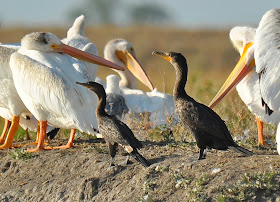Fast-forward to last winter, 2012-2013: It was shaping up to be a record-setting year. For the first time since my big year in 2008, there was a Bohemian Waxwing irruption going on. This normally tough-to-find-species was everywhere. There was also an unprecedented irruption of Common Redpolls going on: a species that had less than five previous records in the county was showing up in flocks of dozens. A few individual birds were noteworthy, too: a vocal Blue Jay was spending the winter in Smithfield and a White-throated Sparrow was coming to a feeder in Logan, for example. These great birds and many others helped the Logan count circle break their Christmas Bird Count record in late December 2012, and indicated a good winter for birding in the county.
The great birds stuck around into the new year, and even more locally rare species started turning up. In the second week of January, Gray-crowned Rosy-Finch, Snow Bunting, and Lapland Longspur were all found. I had found all of these in 2008, but considered myself very lucky to have found them after quite a bit of effort. A flock of Pine Grosbeaks (a rare year-round resident that I missed in 2008) was found feeding on the USU campus on January 15th. On the same day, Black Rosy-Finches were reported from North Logan; I had never seen this species in the county. On January 26th, two Greater Scaup were found, another species I missed in 2008. A Harris's Sparrow was found on January 29th, a species I had in 2008 but only once or twice since. Then, on February 1st, a Snowy Owl was found, only the second in the state since 1967! A great winter was turning into an incredible one.
 |
| This Black Rosy-Finch was one of several coming to a feeder in North Logan. I had never seen this species in the county before this year. (Photo copyright Ryan O'Donnell.) |
After noticing abrupt changes in the birding habits of a few of my friends, I was starting to realize that my Big Year record might be in jeopardy: at least two people were doing big years in the county, and they had picked the perfect year to do it. So, around the beginning of February, I decided to join them: to take advantage of a great winter to try to improve on my Cache County Big Year record. I didn't really WANT to do a big year, but I also didn't want an opportunity like this record-breaking winter to pass me by.
Now, seven months later, I see that I made the right decision. The good birds have kept coming, including several new species for the county, like Summer Tanager, Neotropic Cormorant, and Least Flycatcher. And I'm really happy to be taking another shot at a big year now that I have five years' more experience of birding the area under my belt. I'm finding my birding trips more efficient, now that I know most of the calls of the regular species and I can pass them by in search of rare ones. I know the birding locations better, so I know where to find each species, and I know the changes of the seasons better, so I know when to look for rare species. I also know the people of the area better, so I have more friends to go birding with, more people to give me tips, and more people to share their land with me. In all, I'm glad to be able to give a big year another effort, because it would always bother me knowing that I could improve on my number of 242.
And, improve on that I will. In fact, yesterday was a special day because I surpassed my previous record: my friend Andy and I found a Northern Waterthrush, my 243rd species of the year. I can't wait to see how high a record I can set, a record I know I'll be proud of for years to come.







Nice article O'D. It's an impressive record and I'm glad to have seen most of the rare and incredible birds that have graced Cache County this year. Thanks for all that you've taught me about Cache County birds over the last two years.
ReplyDeleteThanks, Andrew! It has been a pleasure to bird with you, but we need to do it more!
ReplyDeleteYou guys have had some good birds there this year Ryan. The Common Redpolls across Utah was a lot of fun last winter. I wish there were numbers like that every year.
ReplyDelete